Dr Vino's wine blog
wine talk that goes down easy
Fighting back the rosé backlash! In defense of the pink drink
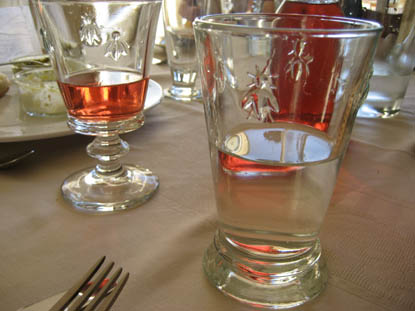
OK, which wine category is hot? Sooo hot? As in up 39 percent nationally for the first six months of this year? That’s right, folks, we’re talking about rosé! Dry rosé!
Just as America is warming up to dry pink wine, Papa Bear Eric Asimov tells us it’s jumped the shark. It’s over. Before it even began! Rosé, we hardly knew ye! EA cries out for rosé therapy on his blog:
But doc, why am I so unhappy about rosés? I don’t want to buy them. I don’t want to drink them. I don’t hate them. I’m just not interested. But I know I’m supposed to care. That is, I’m supposed to be carefree, which is the proper attitude for rosés. You know, lunches in Provence, tapas in Spain, let the rosé flow. But I’m not carefree about rosé. I’m grumpy. What’s wrong with me?…I hate to be a killjoy, doc. Isn’t there anything you can do for me?
Don’t be grumpy, Eric! Just get into the vibe! Although I’m not the kind of doctor you’re looking for, here are some tips for starting to think pink:
1. Context matters: rosé could be the ultimate wine where context matters. When it’s hot, chill it and have it on the deck, at a sidewalk cafe, under a tree, in a hammock–wherever there’s no air conditioning! The hotter you are, the better it will taste. 😉
2. A halfway house for whites and reds: dyed in the wool partisans of whites and reds may not often overlap but rosé may just prove that common ground.
3. Tired of serious wine? It’s a quaffer, easily downed. Refreshment is key. Rosé is almost a state of mind more than it is a wine. (Is this sounding New Age-y yet?)
4. Food friendly: high-acidity dry rosé pairs with a lot of foods, including some hard ones like salads and gazpacho and, of course, anything meaty.
5. Wallet friendly: I’d be grumpy too if I paid a lot for rosé–$15 is my max. This is the first press of some wine or from red vines that aren’t mature enough to do anything interesting so there’s an economic argument for it’s being cheap too. Last summer when we were in the south of France we got a 5L box of the hearty Bergerac rosé for 12 euros, which brought down our per glass costs to practically nothing. It makes you extremely generous when the wine is always cold and your per glass cost is less than a postage stamp–and wine is for sharing!
Some of my favorite dry rosés from this summer:
* Chateau Peyrassol. At $17 it is in my grump-zone, but still very nice light Provencal style. (search)
* Commanderie de Bargemone: Yummy, fresh strawberry notes, good acidity and $12 (search).
* Domaine Houchart (St. Victoire): This wine just makes me think about lunch, outside under an umbrella. $15 (search)
* Domaine Sorin, Terra Amata (Cotes de Provence): Sustainably grown; wonderful with fried calamari (search)
* Chateau d’Aqueria (Tavel): Darker in color and bolder in taste, this is a good one for enticing people from the red side as I did last weekend with a guy who “only drinks red.” Though at $17, it’s into my grumpy price range (search)
* Bodegas Muga (Rioja): easy to find, this one is an even better value at $10 (search)
* Bernard Baudry (Chinon): pleasant, but a tad too serious for mindless summer fun with it’s dollop of minerality (search)
Preppy is back. Drink pink.
Vinexpo, odds ‘n ends, edition 2007
Best spit bucket
Perrin. Try to dump that over yourself, Miles! Yes, I spit my Beaucastel on stones imported from Chateauneuf du Pape.
Cheesiest video
Some continuous loop at the Torres stand about monks in Priorat. Excerpt: “The white light guided us to the land.”
Most groan inducing slogan
Tie! “Rockin’ Rhone” and “California wines: inspired by life”
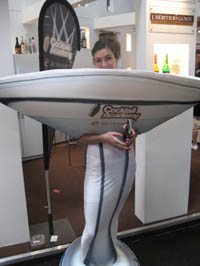 Oddest attire
Oddest attire
Woman dressed up as a martini glass
Best 2006 red tasted at Union des Grands Crus tasting
Leoville Las Cases (search for this wine)
Best 2006 dry white tasted at Union des Grands Crus tasting
Chateau Carbonnieux (search for this wine)
Best red wine tasted
Chateau Le Pin 2001 (from magnum; find this wine)
Worst red wine tasted
Chateau Le Pin 2001 (from magnum–more later; find this wine)
Best white vertical
Tondonia, gran reserva, 1981 – 1964, selected vintages
Best cheese plate table
Chateau Angelus
Best lunch
Vieux Chateau Certan. Yummy oysters!
Oddest animal
Life sized, black plastic stallion in the press room
Best fireworks
La Jurade, St. Emilion, complete with acrobat walking up side of old tower
 Best looking ambassador in ceremonial robes
Best looking ambassador in ceremonial robes
US Ambassador Craig Roberts Stapleton
Worst traffic
Everyday! (especially when leaving)
By the random numbers:
Attendees: around 50,000
Exhibitors: 2,400
Length of lines for sandwiches: 30 yards
Cost of mediocre lunch: 16 euros
Neutral places to sit: way too few
Men seen talking on the cell phone while urinating: 3
People seen wearing Crocs: none
When Vinexpo will be in Hong Kong: 2008
After a seventy year hiatus, reintroducing a “Cuvee hermitagee”
What do you call a Bordeaux merlot blended with some syrah? Alexandre Sirech calls it a cuvée hermitagée. The French authorities also call it a vin de table.
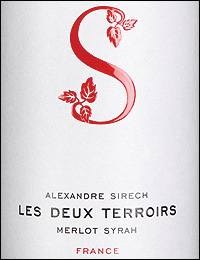 Sirech says that in the 17th and 18th centuries, some of the top wines of Bordeaux had some syrah from Hermitage in the Rhone added to them. With the rise of the appellation system in the early 20th century, this practice became forbidden if the wine was to be labeled with any of the Bordeaux appellations since 100 percent of the wine must come from the appellation.
Sirech says that in the 17th and 18th centuries, some of the top wines of Bordeaux had some syrah from Hermitage in the Rhone added to them. With the rise of the appellation system in the early 20th century, this practice became forbidden if the wine was to be labeled with any of the Bordeaux appellations since 100 percent of the wine must come from the appellation.
He’s launching a new wine called “Les Deux Terroirs” that revives this tradition. (Chateau Palmer in Margaux has also experimented with the idea.) Since it is outside the appellation system it is thus labeled as a vin de table, theoretically the lowest rung on the French system. That means the wine cannot state on the label the place where it comes from (other than France) or the vintage.
Sirech, 40, has been in the wine and spirits business for almost 20 years. He’s had two long stints at Pernod Ricard interrupted by starting his own online wine retailer, ChateauNet, which he sold in 1999. Most recently he ran Havana Club rum for Pernod Ricard out of Havana.
I asked him via email how he saw a need for the wine through the marketplace or the terroir(s). Here’s his reply:
Quite frankly I had been thinking for a long time that the AOC decrees were too limiting. The AOC system has plenty of advantages but one big inconvenience: it prevents innovation. We need the AOCs but I think we also need a modern/free/hedonistic wine like “Les Deux Terroirs”.
Also, I had been selling a lot of Jacob’s Creek for Pernod Ricard in the UK and I had seen the merit of blending Syrah with Merlot or Cabernet, something that was unthinkable in France at that time (early nineties). When I had the idea back in Cuba, I did not know about the cuvées hermitagées. It is only when I started working on a formulation with the Rolland team in Catusseau that I found out about the whole story and I must say it confirmed my intention. I remember thinking that if they were doing this in the 17th, 18th and 19th century at a time when getting Syrah from Hermitage was surely a logistic nightmare, it had to be good for the blend!
Sirech is the buyer and blender of the wine and is advised by Jean-Philippe Fort of Michel Rolland’s winemaking team.
I haven’t tried the 80-20 merlot-syrah blend yet but it will be available in New York, Florida, and Illinois soon (search for this wine). Sirech wrote me that he bypasses the Bordeaux negociant system and maintains Southern Wine & Spirits as both importer and distributor to deliver greater value to the consumer. The wine will retail for $20 and is sold in wood case six packs.
More on French innovation:
“Is Chamarré still trop francais?”
“Yellow jersey, Beaujolais in tin – new products from Boisset“
Arretxea, Hegoxuri, Irouléguy: unpronounceable words you should know
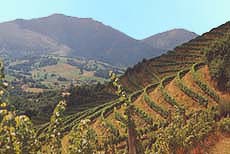 In the bit of the Basque Country that lies on the French side of the Pyrenees is the small appellation of Irouléguy. Don’t worry: I’d never heard of the steeply sloped vineyard area either.
In the bit of the Basque Country that lies on the French side of the Pyrenees is the small appellation of Irouléguy. Don’t worry: I’d never heard of the steeply sloped vineyard area either.
I was in the excellent little shop, La Derniere Goutte in the 6th arrondissement of Paris last week. I told Juan Sanchez, the American owner who seems to know everyone who comes into the shop, that I was looking for an interesting dry white and he pointed me to the Arretxea Hegoxuri from Irouléguy. It’s a blend of 50% petit manseng, 40% gros manseg, 10% corbu–and yes those are all grapes. It’s partially barrel fermented.
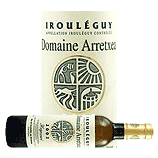 With wildly aromatic notes of tropical fruits–pineapple, melon–the dry wine has a wonderfully balanced acidity and mountain mineral verve on the palate. It’s no doubt makes it the best petit manseng you’ve ever had. And the vignerons, Therese et Michel Riouspeyrous, farm biodynamically.
With wildly aromatic notes of tropical fruits–pineapple, melon–the dry wine has a wonderfully balanced acidity and mountain mineral verve on the palate. It’s no doubt makes it the best petit manseng you’ve ever had. And the vignerons, Therese et Michel Riouspeyrous, farm biodynamically.
But the story does not end there. Bottled as a humble vin de table yet sells for 20 euros, the wine was meant to be an appellation wine. According to the back label, the natural fermentation was slow in 2005 and when it came time to give a sample to the mandatory taste-test component of the residual sugar level was 0.2 grams above the appellation limit. So rather than mess with the wine, the Riouspeyrouses decided to bottle it as a vin de table. That explains why there’s no vintage or region on the wine. And why Juan Sanchez rolled his eyes about how the appellation system doesn’t always help natural wines.
 Someone must import the wine to the US since it is available at Smith & Vine in Brooklyn for $28 (find this wine). The price is a little high–if it were $15 wine it would be a screaming buy–but with the dollar tanking, it’s not likely to get any cheaper, sadly.
Someone must import the wine to the US since it is available at Smith & Vine in Brooklyn for $28 (find this wine). The price is a little high–if it were $15 wine it would be a screaming buy–but with the dollar tanking, it’s not likely to get any cheaper, sadly.
Congratulations to Steve who correctly guessed this difficult, mystery vineyard location–we’d expect nothing less from the founder of the Wine Century Club!
The drying of French politicians
 I stopped by Willi’s Wine Bar, in operation in the 1st arrondissement since 1980, today for lunch. Afterward I fell into conversation with Mark Williamson a.k.a. Willi. He was lamenting the decline of enjoying wine in the political class in France–as evidenced first and foremost by President Sarkozy. He told me in exasperation that a former prime minister was in for lunch yesterday and he didn’t even order wine. Wow. Lunch and no wine, OK, perhaps. But in a wine bar?!?
I stopped by Willi’s Wine Bar, in operation in the 1st arrondissement since 1980, today for lunch. Afterward I fell into conversation with Mark Williamson a.k.a. Willi. He was lamenting the decline of enjoying wine in the political class in France–as evidenced first and foremost by President Sarkozy. He told me in exasperation that a former prime minister was in for lunch yesterday and he didn’t even order wine. Wow. Lunch and no wine, OK, perhaps. But in a wine bar?!?
Mark has a once-a-month sort of blog. Since it’s nearly impossible to find, I’ll post a link here to a recent rant about Sarkozy and a brief overview of the likes and dislikes of other French pols, past and present. My favorite vignette: the last of the hard core Socialist prime minsters, Pierre Mauroy, polished off the official PM’s cellar within a week back in 1981.
Is Chamarré still trop francais?
 Brands. They make the world go round. Or so the theory goes in a world of global competition.
Brands. They make the world go round. Or so the theory goes in a world of global competition.
Some may say that a failing of France, the land of tens of thousands of wine producers, is the lack of big brands. In an effort at consolidation, several cooperatives have come together to try to make and market a new line of wines under the name of Chamarré.
As I zoomed by the large Chamarré stand at Vinexpo, I had a chance to pick up a pamphlet and hear the two-minute story on the wines. The highlights include consolidation of the 13,000 growers under one winemaker, R. Rosari, and rapid growth since they have sold 100,000 cases as they approach their first anniversary of the brand. US launch/expansion will follow in the coming months following the initial push was in the UK (search for the wine).
Soon after leaving their stand, I bumped into two anglophone wine guys who are specialists in the global wine biz. I couldn’t help getting their reaction to this new wine.
Global Guy 1: “Chamarré? I can just see a guy in America ordering that at a bar! Sha-mar-ay. And what if you forget the accent? Then it is Sha-marre. Eww.”
Global Guy 2: “They just don’t have the label right. What’s up with the butterfly?”
Global Guy 1: “What’s this? Four lines of wines? Oh, now THAT’s easy! Wow, they really don’t get it do they. And look–a shiraz, grenache, merlot–the famous SGM blend!” [note: it’s usually GSM for grenache-syrah-mourvedre]
And so on…Unfortunately I wasn’t able to head back to the stand to get their opinions (and gather my own) on what the wines actually taste like. But overall presentation is a potentially large part of the buying experience, so the globetrotters’ reaction was interesting at one level.
What do you think? Will this butterfly take off in the US?
Ace of Spades expands into a full house
 OK quick – who is associated with the champagne Armand de Brignac, aka Ace of Spades, aka Gold Bottle? if you said the hip hop-preneur Jay-Z then you get only partial credit. The producer is in fact the Champagne negociant, Cattier.
OK quick – who is associated with the champagne Armand de Brignac, aka Ace of Spades, aka Gold Bottle? if you said the hip hop-preneur Jay-Z then you get only partial credit. The producer is in fact the Champagne negociant, Cattier.
I spoke with Alexandre Cattier last week at Vinexpo about the wines that he provides to the US market, sold mostly through nightclubs and a handful of stores (find this wine), where the prices range from $300 – $375.
About the opportunity to develop the Ace of Spades, Cattier told me “It’s incredible–it’s one of the occasions that you have once in a lifetime as a negociant.”
I have not tried the wine myself and there was none offered, I might add, since Cattier said that the production was “very limited.” He did tell me that the wine is a brut nonvintage. Hmm, a “limited” brut NV?
Anyway, the brand is expanding. I saw samples of the new bottles, which will now include a shiny pink embalmed brut rose NV and a shiny silver emblamed blanc des blancs brut NV. Feel free to poke around the Cattier web site and see their existing line that includes a rose NV and a blanc des blancs NV. These are available in the US from $25 – $55. (Find these wines)
Related:
“Reader mailbag: finding Ace of Spades Champagne”
“Jay-Z puts an Ace in play”
Yellow jersey, Beaujolais in tin – new products from Boisset
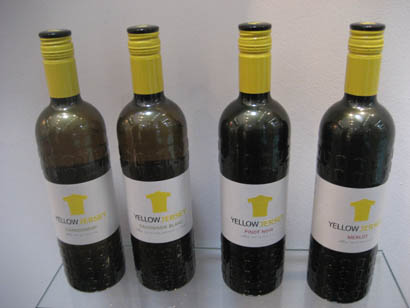
Vinexpo is a time that a lot of wine producers launch new products. Perhaps one of the most experimental producers is the Burgundy-based house, Boisset. They brought the world French Rabbit in TetraPak a year or two ago. Their stand was packed looking at their new releases.
Yellow Jersey is a new wine (not yet available in the U.S.–but maybe one day, find this wine). A screwcap rests atop a plastic bottle with little raised jerseys. Given the recent scandals with professional cycling, one might wonder if the bottle itself has been “juiced.”
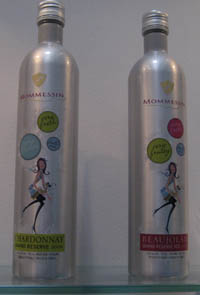 And under the Mommesin brand, they have Beaujolais in a can, ready for chilling. They wrote “Grande Reserve Red” on the can so that people in the store would know what it was that was on the shelf in front of them. There’s also a chardonnay from Macon-Villages.
And under the Mommesin brand, they have Beaujolais in a can, ready for chilling. They wrote “Grande Reserve Red” on the can so that people in the store would know what it was that was on the shelf in front of them. There’s also a chardonnay from Macon-Villages.
A little over three years ago they bought the Sonoma brand De Loach out of Chapter 11. They have ripped up all the vines on the 22 acres surrounding the winery and have let the vineyards lie fallow in a conversion to biodynamics. They’ve just been replanted with pinot noir and chardonnay.
Their packaging innovation continues with an pinot noir from the Sonoma Coast vineyard, Sonoma Stage. Only 150 cases of this pinot noir was produced and 10 of them have been bottled in Stelvinlux, a sort of fancy screwcap. While some consumers might not be able to swallow the $85 price tag, at least the pinot noir in the bottle actually tastes like pinot noir, unlike many from California these days.



